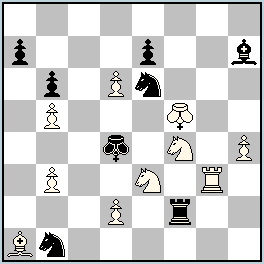|
No.374
Neal Turner (Finland)
Welcome and congratulations to Neal with his first publication on Julia’s Fairies!
|

Original Problems, Julia’s Fairies – 2013 (III): September- December
→Previous ; →Next ; →List 2013(III)
Please send your original fairy problems to: julia@juliasfairies.com
|
No.374 by Neal Turner – A very seldom fairy combination – SAT with Royal Grasshoppers – in s#! (JV)
Definitions:
SAT: A King is under check if it can move to only one square not controlled by the opposite side.
Grasshopper(G): Moves along Q-lines over another unit of either color to the square immediately beyond that unit. A capture may be made on arrival, but the hurdle is not affected.
|
No.374 Neal Turner
Finland
original-12.09.2013
s#2 SAT (10+8)
Royal Grasshoppers: d4, f5
1.Se2! (> 2.rGf1+ rGd1# )
1..Rf3 2.Sf1+ Rd3#
1..Bg8 2.d7+ Sd8#
1..exd6 2.Sd1+ rGg1#
(C+ by Popeye 4.55)
Examining the brG’s flights: d1,d7 & g4, we see that moving is prevented by arrival checks on a1,f7 & e4.
Of the other black pieces, the Rf2 & Se6 are both pinned in the diagram.
The key opens the line for the wrG to come to f1 leaving a check on d7.
With the wrG on f1 the square a1 is now defended, enabling it’s counterpart to land on d1 resulting in check on c1.
The Se2 would like to block on that square but is prevented from doing so because it is pinned to a6!
The first two defences prevent White coming to f1.
The opening of the f-file has given the Rf2 some limited movement – just enough to prevent the threat, but this allows the Se3 to take centre stage.
With 2.Sf1 we check on d1 while at the same time guarding d2.
Vacating the diagonal frees the bR, while the opening of the 3rd rank allows it to defend the check by blocking the line to d1, but the hole created on c2 leaves White checkmated.
1..Bg8 prevents the threat by unguarding d3, but now that the 1st rank is off-limits White turns his attention to the 8th rank.
The pawn move forces the knight to block on d8 opening the line for a check on c8.
The knight prevents the pawn moving on, while the hole on e8 stops the wrG from escaping.
The third defence provides Black with a flight as after 1..exd6 there’s no longer a hole on f7, so the brG is free to run to d7.
White’s reply prevents this by unguarding d5. By playing to d1 he checks on that square while at the same time closing the line to a1.
So Black can, and must, play to g1 and now it’s White that’s checked on d7 and because the white pawn has been captured there’s no possibility to block. (Author)
|




The problem seems very interesting and I believe that it’s indeed interesting.
The explanation seems good and I believe it’s indeed good.
The definition of SAT seems clear and simple but I don’t believe that it’s clear. I tried the other source but that only additionally blurred my faint idea of SAT.
I’ll try again tomorow 🙂
You’re right, Nikola, the definition is more like my understanding and it is really unclear! 🙂
Another one (from StrateGems) is: SAT – A King is in check only if he can move on an unattacked square.
Is this one better?
Yes, the definition of SAT can be perplexing.
My own working definition is simply:
‘A king is in check if any of its flight squares are unguarded by opposing pieces.’
I’m not sure if this can be derived from the ‘official’ definition in the strict sense, but it seems to serve adequately and is certainly less confusing.